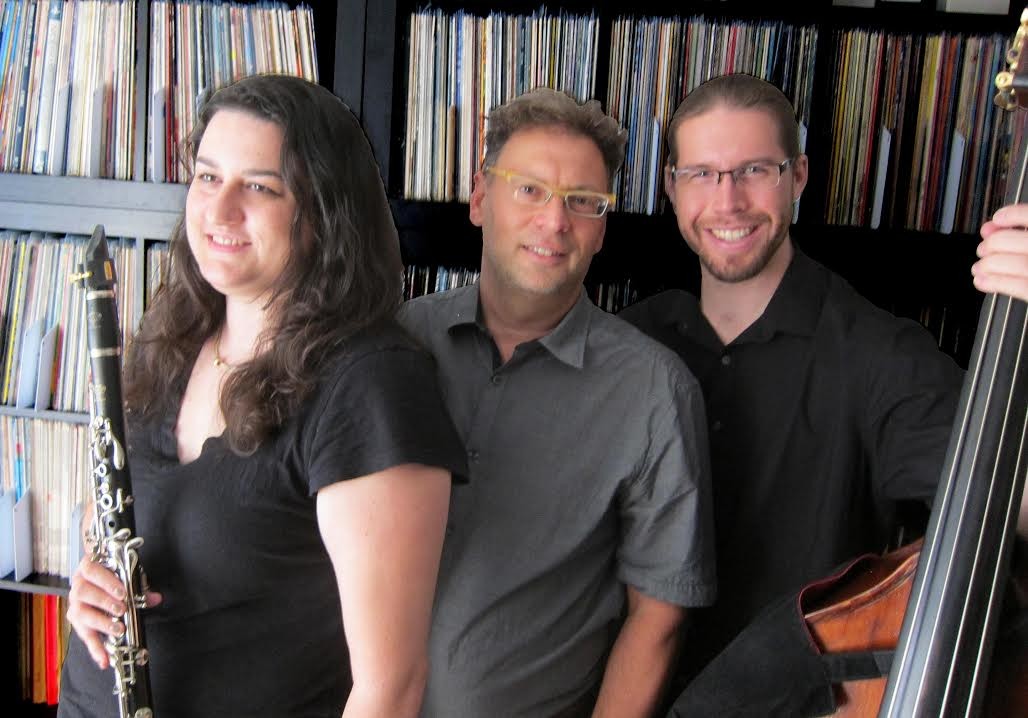
The score for “How I Got to Long Beach” doesn't look like what you'd expect from a composer with years of classical music training in some of the country's best conservatories. In fact, it's not really what you'd expect a score to look like at all.
In order to tell the other two members of his ensemble how to perform his latest multimedia work of experimental music, Long Beach-based avant-garde composer Jack Curtis Dubowsky used a little bit of traditional notation, but mostly screenshots from the accompanying video, idiomatic gestures and vague instructions about what the piece should sound like and when.
It's not uncommon to see directions like “dark chugging” or “excitement, evil” next to more specific, pre-composed material and calls for “staccato!” During live performances of the 45-minute “How I Got to Long Beach”–which debuted last month at Third Eye Records–the audience remains unaware of Dubowsky's bizarre form of written communication.
]
“In jazz improvisation, you have a chord chart and everyone plays along to the changes,” he says. “In free improvisation, it's 'Let's all noodle and get crazy.' And that's great too, but what the ensemble does is structured improvisation. It'll always be the same show, but each time it's played, it'll be different on these subtle levels.”
Dubowksy is a prolific composer, educator and filmmaker with a deep resume in the new music movement. More than just a description of music that is not old, the term “new music” refers to a subgenre of contemporary classical music that pushes the boundaries of tradition with elements of minimalism, art rock and performance art. New music has strong roots in New York's “Downtown Music” scene of the '60s and '70s, which included such composers and artists as Yoko Ono, John Cage, Philip Glass and Steve Reich.
For contemporary composer Dubowsky, his willingness to experiment not only with instruments, but also video and vocals has brought him commissions with open-minded orchestras around the country and also led to hundreds of personal performances at some of the country's most important art venues and galleries.
“I think the whole thing about working in new music is that it provides opportunities to perform and engage audiences because if you're going to wait for symphonies to commission you, it's just not going to happen,” he says. “Let's put something together where we can play new and interesting music and make it happen without waiting for a commission or waiting to be discovered by the establishment.”
The Jack Curtis Dubowsky Ensemble formed in 2008 after its namesake leader had lived in San Francisco and worked throughout the Bay Area's art-music scene (including forming other ensembles) for nearly two decades. In 2010, he took a teaching job in Minneapolis and moved to the Land of 10,000 Lakes, taking the ensemble on several tours of the Midwest and East Coast while there.
[
When the teaching gig was up, however, he found himself priced out of San Francisco and seeking another affordable artist haven. He settled on Long Beach, on the fringes of Los Angeles, where he grew up.
“How I Got to Long Beach” is an autobiographical piece performed by the current iteration of the Jack Curtis Dubowsky Ensemble–an electroacoustic trio consisting of Dubowsky on synth, Scott Worthington on acoustic double bass and Alicia Byer on clarinet–that traces this narrative of Dubowsky's recent moves in a traditional three-movement structure. He wrote it after Third Eye Records owner Gary Farley noticed Dubowsky's obscure experimental electronic vinyl purchases (think Tuxedomoon and Morton Subotnick) and told him he should play at the shop.
More than just one man's story, though, the work touches on larger issues, like the rapid gentrification of once-artist-friendly cities and the financial struggles many artists have to deal with when they work outside of the mainstream.
“If you do really off the wall stuff, you can't really afford to live in places like San Francisco or New York anymore. The cities used to be run down and inexpensive and if you're an artist, that's exactly where you want to be,” he says. “But now there's this huge question, culturally, on a large level: If these cities become these expensive areas, where do our artists go?”
In Dubowsky's case, he lands in Long Beach–a city he sees as teeming with empty storefronts and creative potential–and Southern California, a region he's excited to engage with, even if it means playing record stores and not galleries or concert halls like he's used to (“Record stores are where the interesting cultural discourse is happening out here”).
Still, the nationally recognized composer does not see himself as being artistically tied to a certain place. Long Beach is just where he rests his head right now and the Jack Curtis Dubowsky Ensemble is an interchangeable, roving cast of musician friends that can play through the impressive repertoire of modern works anytime, anywhere, in any space.
“I try not to think of myself as a local composer in any area. That was one of the things that cracked my head open in San Francisco,” he says. “If I can't get booked where I am, that's fine. I'll go play shows somewhere else–in New York, Boston, Providence, Chicago or Des Moines. I'm a national composer and I try to get myself out there as much as possible.”
Jack Curtis Dubowski Ensemble perform “How I Got to Long Beach” at Blue Bag Records in Echo Park on Friday, September 26. Free show. For full details click here.
See also:
10 Jazz Albums to Listen to Before You Die
Ian Anderson's Idea of Rock-n-Roll is More Complex Than You Know
The 25 Greatest OC Bands of All Time: The Complete List
Sarah Bennett is a freelance journalist who has spent nearly a decade covering food, music, craft beer, arts, culture and all sorts of bizarro things that interest her for local, regional and national publications.

